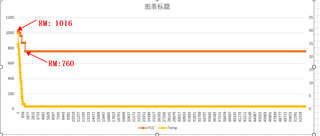Other Parts Discussed in Thread: GPCRB
我们在0℃的环境下,做了1A电流的持续放电测试,确认RM和SOC的变化值,发现了异常的变化。
We did a continuous discharge test with 1A current at 0°C to confirm the change in RM and SOC values and found an abnormal change.
请协助确认下出现如下两种错误情况的原因:
Please assist in confirming the cause of the two error conditions as follows:
1. 日志1中,1A放电开始后,从0℃上升到6℃时,FCC和RM突然变成了一个异常值,并且持续到了测试结束。
1. In log1, after the 1A discharge started, the FCC and RM suddenly became an abnormal value when it rose from 0°C to 6°C and continued until the end of the test.

2. 日志2中,1A放电开始后,在温度是7℃时,FCC,RM,SOC突变为0。
2. In log 2, the FCC, RM, and SOC suddenly change to 0 when the temperature is 7°C after the start of 1A discharge.

Thanks



